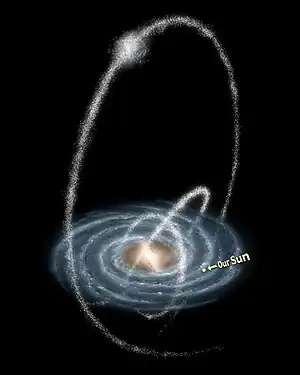Virgo Stellar Stream
The Virgo Stellar Stream, also known as Virgo Overdensity, is the proposed name for a stellar stream in the constellation of Virgo which was discovered in 2005.[1][2] The stream is thought to be the remains of a dwarf spheroidal galaxy that is in the process of merging with the Milky Way. It is the largest galaxy visible from the Earth, in terms of the area of the night sky covered.
| Virgo Stellar Stream | |
|---|---|
 Stellar streams (artist's impression) | |
| Observation data (J2000 epoch) | |
| Constellation | Virgo |
| Right ascension | ? |
| Declination | ? |
| Distance | 30 kly |
| Apparent magnitude (V) | ? |
| Absolute magnitude (V) | ? |
| Characteristics | |
| Type | remains of a dSph |
| Apparent size (V) | 30° × 10° |
| Other designations | |
| none | |
The stream was discovered from photometric data from the Sloan Digital Sky Survey, which was used to create a three-dimensional map of the Milky Way, using the colors and brightness of certain characteristic types of stars to estimate their distance (a method known as "photometric parallax").[3] The first suggestion of a new galaxy in Virgo was made in 2001 from data obtained as part of the QUEST survey, which used the one-metre Schmidt telescope at the Llano del Hato National Astronomical Observatory in Venezuela to search for RR Lyrae variable stars. Five were found in a clump with a right ascension near 12.4 hours, and the astronomers speculated that this clump was part of a small galaxy being "cannibalised" by the Milky Way.[4]
The stream covers over one hundred square degrees and possibly as much as one thousand square degrees (approximately five percent of the hemisphere visible at any one time, or five thousand times the area of the full moon). Despite its proximity to the Solar System and the solid angle that it consequently covers, the stream contains only a few hundred thousand stars. The low surface brightness of the galaxy (possibly as low as 32.5 mag/arcmin2) may have militated against its detection in surveys before SDSS. The number of stars in the stream is not greatly in excess of a star cluster, and it has been described by a member of the team that discovered it as "a rather pathetic galaxy" in comparison to the Milky Way.[5] Many of the stars have been known for centuries and thought of as normal Milky Way stars, although they have a lower metallicity than normal Population I stars in the Milky Way.
The stream lies within the Milky Way, approximately 10 kiloparsecs (30,000 light-years) from the Sun, and extending over a region of space at least 10 kpc across in three dimensions. It is close on the plane of the sky to the Sagittarius Dwarf Elliptical Galaxy, which was found in 1994 through a similar photometric analysis of a star survey.[6] The Sagittarius Dwarf is another small galaxy which is also in the process of merging with the Milky Way; however, it is approximately 4 times further away than the stream, so the two are unlikely to be physically related, although it is possible that the Virgo Stellar Stream is a remnant left behind by the disruption of the Sagittarius Dwarf as it had orbited around the Milky Way.[7] The Virgo Stellar Stream also resembles the Monoceros Ring, found in 2002,[8] which has similarly been attributed to the Canis Major Dwarf Galaxy merging with the Milky Way.
See also
References
- The Sloan Digital Sky Survey Reveals A New Milky Way Neighbor, SDSS press release, January 9, 2006
- Sonia Duffau, et al., 2006, Spectroscopy of QUEST RR Lyrae Variables: the new Virgo Stellar Stream, The Astrophysical Journal, Volume 636, Issue 2, pp. L97-L100 (ADS; arXiv:astro-ph/0510589
- Mario Juric, et al., October 2005, The Milky Way Tomography with SDSS, The Astrophysical Journal, submitted (arXiv:astro-ph/0510520)
- Katherina Vivas et al., 2001, The QUEST RR Lyrae Survey: Confirmation of the Clump at 50 Kiloparsecs and Other Overdensities in the Outer Halo, The Astrophysical Journal, Volume 554, Issue 1, pp. L33-L36.
- "Stellar chemistry: Sloan Survey identifies new dwarf galaxy inside Milky Way". Space Daily. 10 January 2006. Retrieved 12 June 2018.
- Ibata, R. A., et al., 1994, A Dwarf Satellite Galaxy in Sagittarius, Nature, Volume 370, Number 6486, p. 194.
- The origin of the Virgo tidal stream Archived 2012-02-08 at the Wayback Machine, David Martínez-Delgado, Workshop on Dwarf Galaxies as Astrophysical and Cosmological Probes, 17 March 2006. (PDF)
- Newberg, H. J., et al., 2002, The Ghost of Sagittarius and Lumps in the Halo of the Milky Way, The Astrophysical Journal, Volume 569, Issue 1, pp. 245-274
External links
- Scientists find a galaxy joining ours (International Herald Tribune, 10 January 2006)
- New Milky Way neighbor (Astronomy, 12 January 2006)
